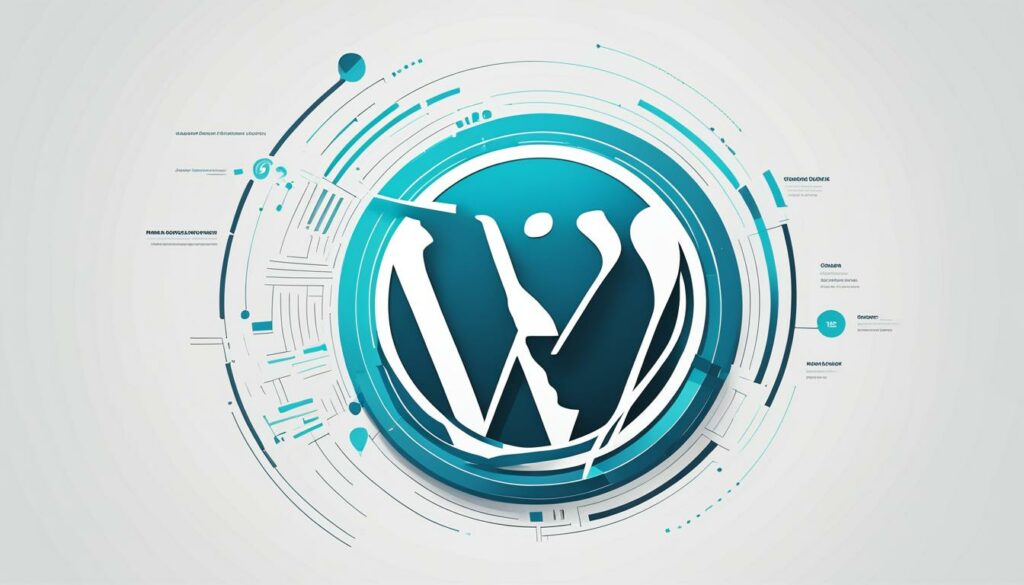Welcome to the future of content management! In this article, we will explore the exciting potential of using WordPress as a headless CMS. You may be familiar with WordPress as a popular CMS for building traditional websites and blogs. However, by decoupling WordPress from its frontend, we unlock a world of possibilities for flexibility and performance in web development.
Using WordPress as a headless CMS means separating the backend from the frontend, allowing for more creative and customized solutions. This decoupling opens up avenues for omnichannel and progressive web development, where content and data can be consumed and aggregated from various sources. The key to this transformation lies in the WordPress REST API, which enables seamless integrations with different front-end technologies.
With headless WordPress, developers have the freedom to choose any technology for displaying content, which ultimately results in a more tailored and interactive user experience. By leveraging the power of WordPress as a headless CMS, businesses can stay ahead of the curve in the rapidly changing digital landscape.
Key Takeaways:
- WordPress can be used as a headless CMS, separating the backend from the frontend.
- Headless CMS offers flexibility and customization options in web development.
- The WordPress REST API plays a crucial role in enabling seamless integrations with different front-end technologies.
- Headless WordPress provides benefits such as flexibility, scalability, and the ability to integrate with other systems and technologies.
- Using WordPress as a headless CMS empowers developers to deliver content across various platforms and devices, adapt to new trends, and create personalized customer experiences.
Ready to embrace the future of content management? Sign up now for WordPress Hosting from BoostedHost to ensure optimal performance for your headless WordPress site!
Sign up now
What is a Headless CMS?
A headless CMS is a modern approach to content management that prioritizes data capture, storage, and delivery without being bound to a specific front-end technology or presentation layer. Unlike traditional CMS solutions, which tightly couple the backend with the frontend, a headless CMS offers unparalleled flexibility and customization options for developers.
With a headless CMS, you have the freedom to use any technology to display content, giving you complete control over the user experience. By decoupling the content management from the frontend display, you can easily adapt and deliver content to different platforms and devices, ensuring a seamless user experience across the digital landscape.
Headless CMS unlocks the true potential of your content by enabling omnichannel and progressive solutions. Whether you’re building a website, a mobile app, or even a voice assistant integration, a headless CMS allows you to consume and aggregate content from various sources, empowering you to deliver content in a way that suits your specific needs.
“A headless CMS provides developers with the freedom to use any technology to display content, offering greater flexibility and customization options.”
In a headless CMS architecture, the content is structured and stored separately from the presentation layer, which enhances scalability, performance, and versatility. You can easily integrate with third-party services, use multiple front-end frameworks, and leverage emerging technologies as soon as they become available. This flexibility ensures that your content can adapt and thrive in a rapidly evolving digital landscape.
Headless CMS Benefits:
- Flexibility: Choose any front-end technology to display content.
- Customization: Tailor the user experience to fit your exact requirements.
- Scalability: Handle increasing amounts of data and traffic effortlessly.
- Future-Proofing: Stay ahead of technology trends and adapt quickly.
- Efficiency: Reuse and repurpose content across various channels.
- Integration: Seamlessly connect with different systems and services.
Headless CMS offers unparalleled flexibility and endless possibilities for your content-driven projects. Whether you’re a developer or a content creator, embracing a headless CMS can revolutionize the way you manage, distribute, and display your content.
WordPress as a Conventional CMS
WordPress is widely known as a powerful and versatile CMS that powers millions of websites and blogs. It offers a user-friendly interface for content creation, management, and organization. WordPress provides a range of themes and plugins that enable users to customize the appearance and functionality of their websites. However, as a conventional CMS, WordPress is primarily designed for traditional, monolithic websites, where the backend and frontend are tightly integrated.
WordPress as Headless CMS
By leveraging the WordPress REST API, you can unlock the full potential of WordPress as a headless CMS. The REST API allows seamless retrieval and manipulation of data stored in WordPress, making it accessible via standardized API calls. This decoupling of the backend from the frontend empowers developers to use WordPress as a robust content creation and management tool while delivering the content to various front-end technologies or applications.
Headless WordPress offers a multitude of benefits:
- Flexibility: With headless WordPress, you have the freedom to choose the front-end technology that best suits your project, whether it’s React, Angular, or any other framework.
- Scalability: The decoupled nature of headless WordPress allows for horizontally scaling the front-end and back-end independently, optimizing performance and accommodating increasing traffic demands.
- Integration: You can seamlessly integrate headless WordPress with other systems and technologies, such as e-commerce platforms, mobile apps, or third-party APIs, enabling a more comprehensive and connected digital ecosystem.
- API-driven Websites: Headless WordPress is ideal for building API-driven websites, where the content can be easily consumed and displayed on multiple channels, such as websites, mobile apps, and smart devices.
Headless WordPress provides developers with the best of both worlds: the familiar and powerful content management capabilities of WordPress backend and the flexibility to create dynamic and personalized user experiences using modern front-end technologies.
If you’re looking for optimal performance and reliability for your headless WordPress setup, we recommend WordPress Hosting from BoostedHost. They offer specialized hosting plans designed to meet the unique requirements of headless architectures. Sign up now through this link: www.boostedhost.com/wordpress-hosting.
How to Use WordPress as a Headless CMS
To utilize WordPress as a headless CMS, follow these step-by-step instructions:
- Decoupling WordPress: Begin by decoupling WordPress from its frontend. Use a blank theme to separate the backend from the frontend architecture.
- Installing Essential Plugins: Install the necessary plugins to enable API functionality. Start with the WordPress REST API plugin and the WP-API Basic Authentication handler.
- Customizing the WordPress REST API: Customize and extend the WordPress REST API according to your specific requirements. Tailor it to suit your project’s needs and ensure seamless integration with other systems and technologies.
- Customizing the Backend: Optionally, customize the backend of WordPress to remove any unnecessary HTML added by the editor. Create custom data fields to cater to your specific content management needs.
Note: Boost the performance of your headless WordPress site with WordPress Hosting from BoostedHost. Sign up now through this link.
Additional Considerations
It’s important to keep in mind that while using WordPress as a headless CMS offers numerous advantages, it also requires expertise in decoupled architectures, API integrations, and frontend technologies. Ensure that your development team has the necessary skills and resources to successfully implement and maintain a headless WordPress setup.
“Using WordPress as a headless CMS provides flexibility in frontend development, allowing for the use of various technologies to display content.”
Web Development and the Importance of Headless WordPress
When it comes to web development, WordPress has been a popular choice for building websites. However, the emergence of headless WordPress has introduced new possibilities and benefits in the field.
Headless WordPress offers developers maximum flexibility in choosing and implementing front-end technologies. Unlike traditional WordPress setups, where the backend and frontend are tightly integrated, headless WordPress allows developers to decouple the backend CMS from the frontend, enabling more creative and interactive user experiences.
The decoupled architecture of headless WordPress brings significant advantages in scalability and performance. With the separation of the backend focusing solely on content management, websites built with headless WordPress can achieve faster loading times without the need to generate entire pages for every request.
Moreover, headless WordPress empowers web developers to adapt their websites to new trends, devices, and platforms more easily. With the ever-changing digital landscape, it is crucial to stay ahead and provide seamless user experiences across various channels.
By leveraging headless WordPress, developers can achieve the following benefits:
- Flexibility in choosing front-end technologies
- Enhanced scalability and performance
- Adaptability to new trends, devices, and platforms
- Seamless integration with other systems and technologies
Headless WordPress gives you the freedom to explore the latest web development technologies and create unique user experiences while ensuring optimal performance.
BoostedHost offers WordPress Hosting specifically optimized for headless WordPress setups. Take advantage of their industry-leading infrastructure and sign up now to boost your web development projects with headless WordPress. Visit www.boostedhost.com/wordpress-hosting for more information.
| Benefits of Headless WordPress in Web Development | |
|---|---|
| Flexibility in choosing and implementing front-end technologies | ✓ |
| Enhanced scalability and performance | ✓ |
| Adaptability to new trends, devices, and platforms | ✓ |
| Seamless integration with other systems and technologies | ✓ |
The Future of Content Management: Headless WordPress
As the digital landscape continues to evolve, headless WordPress emerges as the future of content management. With its innovative approach, headless WordPress transforms the traditional CMS model by acting as a central hub for consuming and aggregating content from various sources. This dynamic shift opens up a world of opportunities for developers and content creators alike.
One of the key features that propels headless WordPress to the forefront is the WordPress REST API. This powerful API allows seamless integration with other tools and services, enabling the creation of complex multi-service workflows. Developers can effortlessly connect WordPress with various systems, creating a unified environment for content management and distribution. The versatility and flexibility of headless WordPress make it a future-proof CMS solution for organizations of all sizes.
By decoupling the frontend delivery from the CMS, headless WordPress empowers developers to build multiple frontends using the same content. This flexibility allows for personalized customer journeys and tailored content experiences across different channels. Whether it’s a website, a mobile app, or even voice-activated devices, headless WordPress ensures a consistent and engaging content delivery. With seamless third-party integrations, businesses can expand their reach and provide a comprehensive user experience.
To fully grasp the transformative power of headless WordPress, consider the example of a media company. Using headless WordPress, they can centralize their content management while catering to the specific needs of various platforms. With a unified CMS, they streamline their editorial workflows, achieving greater efficiency and control. Whether it’s publishing articles, videos, or podcasts, headless WordPress serves as a content powerhouse for content creators and consumers alike.
Benefits of Headless WordPress
Headless WordPress offers numerous benefits for content management. By utilizing its capabilities, businesses can:
- Unlock the potential of multi-channel content distribution, reaching audiences across platforms and devices.
- Seamlessly integrate with third-party systems and services, expanding functionality and enhancing user experiences.
- Customize front-end experiences using different technologies, enabling creativity and interactive user interfaces.
- Streamline workflows and save time by reusing content across multiple channels while maintaining consistent branding and messaging.
- Improve performance and scalability by separating the frontend delivery from the backend CMS.
With these benefits in mind, it’s clear that headless WordPress is poised to shape the future of content management. Its ability to centralize content, empower developers, and create tailored experiences across platforms makes it an invaluable tool for businesses seeking a versatile and scalable CMS solution. Make the leap into the future of content management with headless WordPress and experience the endless possibilities it has to offer.

We recommend WordPress Hosting from BoostedHost for optimal performance. Sign up now through this link: www.boostedhost.com/wordpress-hosting
The Transformative Power of Headless WordPress
Headless WordPress has the power to revolutionize the world of content management. By decoupling the backend CMS from the frontend, developers gain unprecedented control and flexibility in designing and delivering content to various platforms. With headless WordPress, content management is centralized while allowing the use of diverse front-end technologies. This approach provides a scalable and future-proof solution for content distribution, ensuring a seamless user experience across different devices and channels.
When you embrace headless WordPress, you open up a world of possibilities. The decoupling of the backend and the freedom to choose different front-end technologies empowers you to create unique and engaging user experiences. Whether you want to build a mobile app, a responsive website, or an interactive web application, headless WordPress enables you to seamlessly deliver content across multiple platforms and devices.
With headless WordPress, you are not limited by the constraints of a traditional CMS. You have the freedom to experiment with cutting-edge technologies, customize the user interface, and optimize performance according to your specific needs. This transformative solution empowers you to stay ahead of the curve and adapt to the evolving trends in content consumption.
“Using headless WordPress allowed us to break free from the limitations of traditional CMS solutions. We were able to deliver our content in a more flexible and efficient manner, resulting in enhanced user experiences and improved performance.”
Headless WordPress serves as a powerful CMS solution, enabling you to future-proof your content management strategy. By separating the frontend from the backend, you can easily adapt your websites and applications to emerging technologies and devices. Whether it’s virtual reality, voice assistants, or the Internet of Things, headless WordPress empowers you to embrace the future of digital experiences.
Benefits of Headless WordPress
Headless WordPress offers numerous benefits for developers and content creators. By utilizing WordPress as a headless CMS, you gain full control over the content management system, allowing for customization and seamless integration with other systems and services. Here are the key advantages of using WordPress as a headless CMS:
- Flexibility in Front-End Technologies: With headless WordPress, you have the freedom to choose and implement any front-end technology that best suits your project. Whether it’s React, Angular, or Vue.js, you can deliver content to different devices and platforms using the technology that fits your specific needs.
- Reuse of Content: Headless WordPress enables you to reuse content across multiple channels with ease. You can create content once and deliver it to various platforms, such as websites, mobile apps, and social media, maximizing your content’s reach and saving time and resources.
- Scalability and Adaptability: Headless WordPress provides scalability and adaptability, allowing your website to handle increased traffic and adapt to evolving business needs. By separating the backend from the frontend, you can independently upgrade and scale each component as required.
- Improved Performance: Compared to traditional CMS setups, headless WordPress improves performance by eliminating the need to generate entire pages. The focus on content management without the rendering of frontend elements results in faster page loading times and an enhanced user experience.
When utilizing headless WordPress, it’s crucial to choose a reliable hosting provider that supports headless architectures and offers optimal performance for API-driven setups. We recommend WordPress Hosting from BoostedHost for exceptional performance and expert support.
Unlock the potential of headless WordPress and experience the benefits it brings to your development workflow and content delivery.
Case Studies: TechCrunch and Fairfax Media
TechCrunch and Fairfax Media are prime examples of organizations that have successfully implemented headless WordPress as their CMS of choice. Let’s take a closer look at how these companies leveraged the power of headless WordPress to drive their content strategies.
TechCrunch: Decentralizing Publishing with Headless WordPress
TechCrunch, a leading technology publication, embraced headless WordPress to revolutionize their publishing experience. By decoupling the backend content management system from the frontend, TechCrunch gained the flexibility to adapt and customize their editorial workflows.
The editorial team at TechCrunch benefits from the simplicity and familiarity of WordPress, while the frontend developers utilize React to create an intuitive and user-friendly website. This combination allows TechCrunch to efficiently deliver news and articles to their audience, maintaining their reputation as a trusted source of technology insights.
Fairfax Media: Powering Multi-Channel Publishing with Headless WordPress
Fairfax Media, a renowned media company, harnessed the power of headless WordPress to streamline their multi-channel publishing strategy. By adopting a headless approach, Fairfax Media successfully provides a seamless content experience across their websites, mobile apps, and other channels.
The decoupled nature of headless WordPress enables Fairfax Media to centrally manage and distribute content across various platforms. This strategy ensures consistent branding, user experience, and engagement, regardless of the device or channel being used by their audience.
With headless WordPress, Fairfax Media can easily maintain and update their content without having to deal with complex integrations or limitations imposed by traditional CMS systems, giving them a competitive edge in the fast-paced media industry.
Benefits of Headless WordPress: A Comparison
Both TechCrunch and Fairfax Media have experienced the significant benefits of implementing headless WordPress. Here’s a comparison of the key advantages these organizations have gained:
| Benefits | TechCrunch | Fairfax Media |
|---|---|---|
| Editorial Simplicity | 
|
|
| Flexible Frontend | 
|

|
| Multi-Channel Publishing | 
|
|
| Centralized Content Management | 
|

|
These case studies demonstrate the real-world applications and benefits of utilizing headless WordPress. From enhancing editorial workflows to empowering multi-channel publishing, headless WordPress offers organizations the flexibility, scalability, and control they need to thrive in today’s digital landscape.
Hosting a Headless WordPress Site
Hosting a headless WordPress site requires careful consideration of specific requirements and configurations to ensure optimal performance and reliability. When choosing a hosting provider for your headless WordPress site, it’s important to select one that supports headless architectures and offers comprehensive support for API-driven setups.
One recommended hosting provider for headless WordPress is BoostedHost. They specialize in WordPress hosting and have tailored their services to meet the unique needs of headless WordPress setups. BoostedHost provides reliable and flexible hosting services that deliver fast and seamless content delivery to your front-end applications.
| Hosting Provider | Features | Price |
|---|---|---|
| BoostedHost | Specialized WordPress hosting for headless setups | Starting at $19.99/month |
| Another Hosting Provider | Some features | Starting at $XX.XX/month |
| Yet Another Hosting Provider | Some features | Starting at $XX.XX/month |
Server Configurations for Headless WordPress
In addition to choosing the right hosting provider, server configurations play a crucial role in ensuring the efficient handling of API requests and the smooth delivery of content. Here are some recommended server configurations for headless WordPress:
- Use a caching mechanism to improve performance and reduce server load.
- Implement server-side caching to minimize the processing time required for API requests.
- Optimize server settings to handle multiple concurrent API requests and ensure high scalability.
- Consider using load balancing techniques to distribute incoming API requests across multiple servers for improved reliability and performance.
- Regularly monitor server health and performance to identify and address any bottlenecks or issues.
Remember, choosing the right hosting provider and configuring your server properly are essential for hosting a headless WordPress site that delivers fast and seamless content. With BoostedHost’s specialized WordPress hosting and the recommended server configurations, you can optimize the performance and reliability of your headless WordPress site.
Sign up for BoostedHost’s WordPress Hosting
BoostedHost offers reliable and flexible hosting services specifically tailored for headless WordPress setups. To take advantage of their optimized hosting environment, sign up for BoostedHost’s WordPress Hosting now through this link: www.boostedhost.com/wordpress-hosting.
Conclusion
In conclusion, using WordPress as a headless CMS offers a multitude of benefits for content management. By decoupling the backend from the frontend, developers have complete control over the customization and delivery of content. The WordPress REST API further enhances this flexibility by enabling seamless integration with other systems and technologies.
With headless WordPress, you can deliver content across various platforms and devices, adapting to new trends and creating personalized customer experiences. The scalability and future-proof nature of headless WordPress ensure that your content remains engaging and consistent, regardless of the digital landscape.
We recommend WordPress Hosting from BoostedHost for optimal performance. Their hosting services are tailored to support headless architectures and provide reliable performance for API-driven setups. Sign up now through this link and unlock the full potential of using WordPress as a headless CMS.
FAQ
Q: What is a headless CMS?
A: A headless CMS is a content management system that focuses solely on data capture, storage, and delivery without being tied to a specific front-end technology or presentation layer. It allows developers to use any technology to display content, offering greater flexibility and customization options.
Q: How is WordPress used as a headless CMS?
A: WordPress can be used as a headless CMS by decoupling the backend from the frontend and leveraging the WordPress REST API. This allows developers to use WordPress for content creation and management while delivering the content to various front-end technologies or applications.
Q: What are the benefits of using WordPress as a headless CMS?
A: Using WordPress as a headless CMS provides benefits such as flexibility, scalability, and the ability to integrate with other systems and technologies. It also allows for maximum control over the user experience and makes it easier to adapt the content delivery to different platforms and devices.
Q: How can I use WordPress as a headless CMS?
A: To use WordPress as a headless CMS, you need to decouple WordPress from its frontend using a blank theme. Then, install plugins like the WordPress REST API and WP-API Basic Authentication handler to enable API functionality. The WordPress REST API can be further customized and extended based on your specific requirements.
Q: What is the importance of headless WordPress in web development?
A: Headless WordPress offers maximum flexibility in choosing and implementing front-end technologies, resulting in more creative and interactive user experiences. It also enhances scalability and performance by focusing solely on content management without generating entire pages.
Q: How does headless WordPress transform content management?
A: Headless WordPress acts as a central hub for consuming and aggregating content from various sources. With the WordPress REST API, it can easily integrate with other tools and services, enabling the creation of complex multi-service workflows. Headless WordPress allows for the separation of frontend delivery from the CMS, empowering developers to build multiple frontends using the same content.
Q: What are the benefits of headless WordPress?
A: Headless WordPress offers benefits such as full control over the CMS, flexibility in choosing front-end technologies, content reuse across multiple channels, scalability, adaptability, improved performance, and seamless third-party integrations.
Q: Can you provide examples of organizations using headless WordPress?
A: TechCrunch and Fairfax Media are two notable examples of organizations that have successfully implemented headless WordPress. TechCrunch decentralized their publishing experience using WordPress as a backend and React as a frontend, while Fairfax Media used headless WordPress to power their multi-channel publishing strategy.
Q: What should I consider when hosting a headless WordPress site?
A: When hosting a headless WordPress site, it’s important to choose a provider that supports headless architectures and provides optimal performance for API-driven setups. Server configurations should be properly tailored to handle API requests efficiently, ensuring fast and reliable content delivery.
Q: Why should I consider using WordPress as a headless CMS?
A: WordPress as a headless CMS offers a future-proof, flexible, and scalable solution for content management. It provides developers with maximum control and customization options, seamless integration with other systems and technologies, and the ability to deliver content across various platforms and devices.












